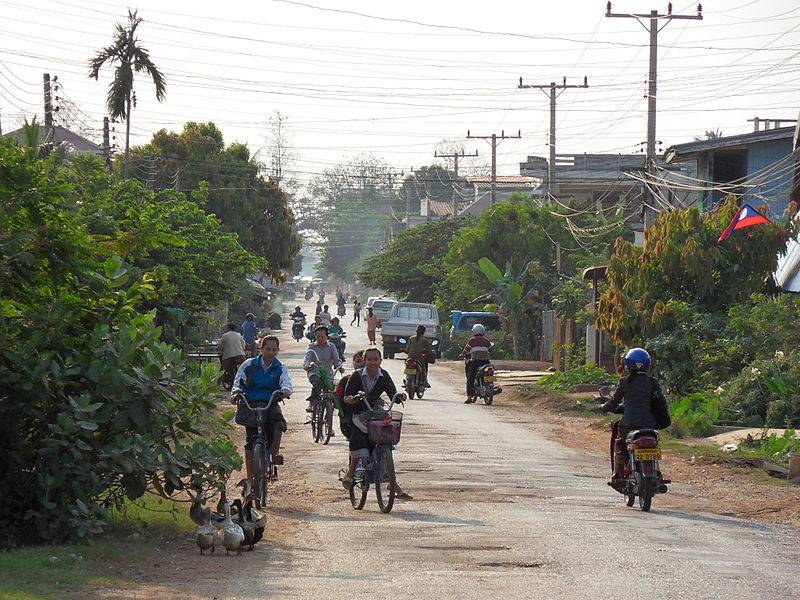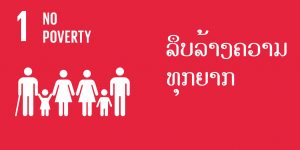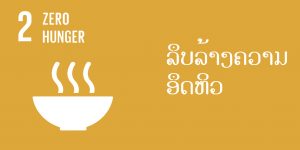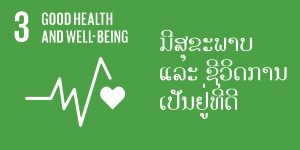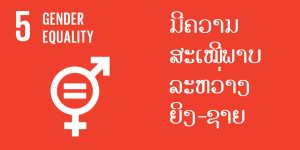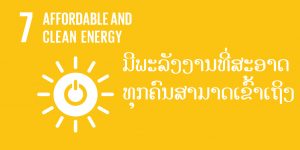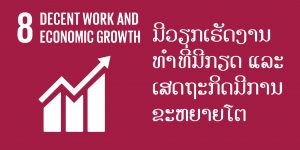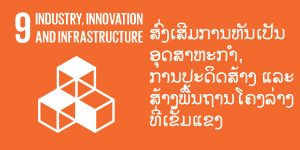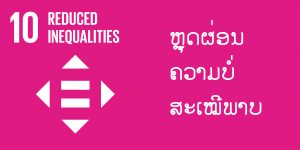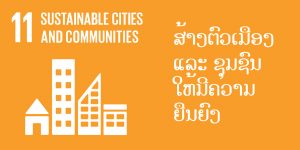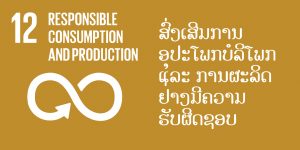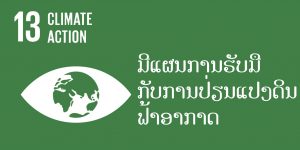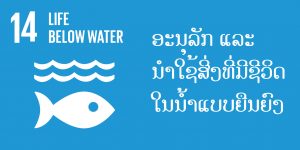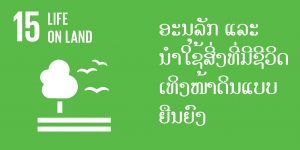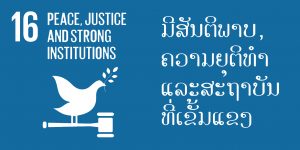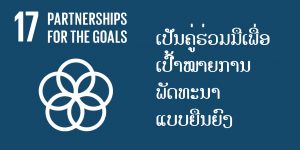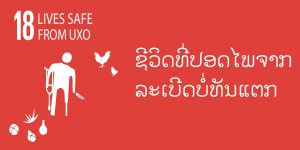ເດືອນກັນຍາ 2015 ສະພາສະຫະປະຊາຊາດໄດ້ເຜີຍແຜ່ວາລະການປະຊຸມກ່ຽວກັບການພັດທະນາແບບຍືນຍົງ ເຊິ່ງປະກອບດ້ວຍ 17 ເປົ້າໝາຍການພັດທະນາແບບຍືນຍົງ (SDGs). SDGs ແມ່ນພັດທະນາມາຈາກເປົ້າໝາຍການພັດທະນາແຫ່ງສະຫະສະວັດ (MDGs)1 ແລະ ມີຈຸດປະສົງເພື່ອຊຸກຍູ້ການປະຕິບັດງານໃນຂົງເຂດການພັດທະນາທີ່ສຳຄັນ ໃຫ້ສຳເລັດທັງໝົດພາຍໃນປີ 2030. ເປົ້າໝາຍດັ່ງກ່າວແບ່ງເປັນ 169 ເປົ້າໝາຍຍ່ອຍ ແລະ 232 ຕົວຊີ້ວັດ.2
SDGs ຕ່າງຈາກ MDGs ຢູ່ບ່ອນວ່າ SDGs ແມ່ນນຳໃຊ້ສຳລັບທຸກໆປະເທດ ໂດຍບໍ່ຈຳແນກລະດັບການພັດທະນາຂອງແຕ່ລະປະເທດ. SDGs ຍັງຮັກສາເປົ້າໝາຍດ້ານສັງຄົມຄືເກົ່າ ແຕ່ຈະເນັ້ນເພີ່ມເຕີມໃສ່ບັນຫາເລັ່ງດ່ວນທາງດ້ານສິ່ງແວດລ້ອມທີ່ທົ່ວໂລກກຳລັງຜະເຊີນໃນປະຈຸບັນ. ເຊັ່ນດຽວກັນກັບ MDGs, ລັດຖະບານ ສປປ ລາວ ໄດ້ປັບເປົ້າໝາຍ SDGs ໃຫ້ແທດເໝາະກັບສະພາບການຕົວຈິງພາຍໃນປະເທດ ແລະ ໄດ້ເພີ່ມເປົ້າໝາຍ SDGs ເພື່ອການຫຼຸດຜ່ອນຜົນກະທົບຈາກລະເບີດທີ່ຍັງບໍ່ທັນແຕກ (ລບຕ) ທີ່ຍັງຄົງຄ້າງໃນລາວ.3
ການຫັນປ່ຽນຈາກ MDGs ຫາ SDGs ຂອງລາວ
ທ້າຍປີ 2015 ສປປ ລາວໄດ້ນຳໃຊ້ວາລະການພັດທະນາແຫ່ງສະຫະສະວັດ ເພື່ອຫຼຸດຜ່ອນຄວາມທຸກຍາກ, ການຂາດສານອາຫານ, ແລະ ອັດຕາການຕາຍຂອງເດັກນ້ອຍ ກໍຄືບັນລຸການສຶກສາຊັ້ນປະຖົມໃນທົ່ວປະເທດ. ເຖິງວ່າ, ລາວສາມາດປະຕິບັດ MDGs ໄດ້ເຖິງ 8 ໃນ 9 ເປົ້າໝາຍ, ແຕ່ກໍຍັງບໍ່ສາມາດບັນລຸເປົ້າໝາຍທັງໝົດໄດ້ຢ່າງເຕັມເມັດເຕັມໜ່ວຍ.4
ໃນຂະນະດຽວກັນ ປະເທດລາວກໍພະຍາຍາມຜັນຂະຫຍາຍ ແລະ ຮຽບຮຽງ MDGs ໃຫ້ເຂົ້າກັບແຜນພັດທະນາເສດຖະກິດ-ສັງຄົມແຫ່ງຊາດ ແຕ່ກໍຍັງພົບຂໍ້ຫຍຸ້ງຍາກຫຼາຍປະການ ເຊັ່ນ:
- ຄາດຄະເນງົບປະມານປະຈຳປີໃນການຈັດຕັ້ງປະຕິບັດ MDGs ແມ່ນເກືອບ 1.3 ຕື້ໂດລາສະຫະລັດ ເຊິ່ງເປັນກ້ອນທຶນຈຳນວນມະຫາສານທີ່ຕ້ອງຂົນຂວາຍ.5
- ລາວເປັນປະເທດທີ່ມີລາຍຮັບຕ່ຳ, ບໍ່ມີຊາຍແດນຕິດທະເລ ແລະ ມີຫຼາຍຊົນເຜົ່າໃນເຂດຫ່າງໄກສອກຫຼີກ ເຊິ່ງໃຊ້ພາສາປາກເວົ້າທີ່ແຕກຕ່າງກັນ. ເນື່ອງຈາກວ່າ ປະຊາຊົນສ່ວນໃຫຍ່ແມ່ນເຮັດອາຊີບກະສິກຳ ເຮັດໃຫ້ມີຂໍ້ຫຍຸ້ງຍາກໃນການປັປປຸງຜົນຂອງການພັດທະນາ.6
- ວິທີການທີ່ລັດຖະບານນຳໃຊ້ເພື່ອເລັ່ງມືໃນການພັດທະນາທາງດ້ານເສດຖະກິດ ໄດ້ສົ່ງຜົນເສຍຫຼາຍຢ່າງ. ໃນທ້ອງຖິ່ນທີ່ອາໄສຊັບພະຍາກອນທຳມະຊາດໃນການດຳລົງຊີວິດ ການເຂົ້າເຖິງການແພດ ແລະ ການສຶກສາຍັງຕ່ຳ, ໂດຍສະເພາະສຳລັບແມ່ຍິງ. ການພັດທະນາແບບກ້າວກະໂດດ ຍັງສົ່ງຜົນຕໍ່ການຂາດໂພຊະນາການ ແລະເຮັດໃຫ້ການຈະເລີນເຕີບຕົວຂອງເດັກນ້ອຍຫຼຸດລົງ.7
ຖະໜົນໃນສະຫວັນນະເຂດ, ລາວ. ແຫຼ່ງຂໍ້ມູນ: Wikipedia Commons – Chaoborus (own work). ລິຂະສິດ: GNU Free Documentation License, Version 1.2.
ປີ 2015 ແລະ 2016 ລາວໄດ້ທົບທວນບັນຫາເຫຼົ່ານີ້ຜ່ານຂະບວນການວາງແຜນແຫ່ງຊາດ ແລະ ສ້າງແຜນພັດທະນາເສດຖະກິດສັງຄົມແຫ່ງຊາດ ຄັ້ງທີ 8 (NSEDP) (2016-2020).8 ເຊິ່ງແຜນດັ່ງກ່າວໄດ້ສ້າງໃຫ້ສອດຄ່ອງຕາມເປົ້າໝາຍການພັດທະນາແບບຍືນຍົງ ກໍແນໃສ່ເຮັດໃຫ້ປະເທດຊາກຫຼຸດພົ້ນຈາກສະພາບດ້ອຍພັດທະນາທີ່ສຸດ ພາຍໃນປີ 2020.9
ການຫັນ SDGs ເຂົ້າສູ່ແຜນນະໂຍບາຍ
ສປປ ລາວ ເປັນປະເທດໜຶ່ງທີ່ມີການເຕີບຕົວທາງເສດຖະກິດໄວທີ່ສຸດໃນພາກພື້ນອາຊີຕາເວັນອອກ ແລະ ປາຊິຟິກ ແຕ່ວ່າການເຕີບຕົວດັ່ງກ່າວມີລັກສະນະບໍ່ສະໝ່ຳສະເໝີ ແລະ ໂດຍຫຼັກແມ່ນອີງໃສ່ການນຳໃຊ້ຊັບພະຍາກອນທຳມະຊາດ ເຊັ່ນ: ພະລັງງານໄຟຟ້ານ້ຳຕົກ, ບໍ່ແຮ່ ແລະ ກະສິກຳປ່າໄມ້. ການເຕີບຕົວດ້ານເສດຖະກິດໄດ້ສົ່ງຜົນໃຫ້ເກີດການສູນເສຍພື້ນທີ່ປ່າໄມ້ ແລະ ຄວາມຫຼາກຫຼາຍດ້ານຊີວະນາໆພັນຢ່າງວ່ອງໄວ.10
ຜົນກະທົບຈາກການປ່ຽນແປງຂອງສະພາບອາກາດ ເຊັ່ນ ໄພນ້ຳຖ້ວມ, ໄພແຫ້ງແລ້ງ ແລະ ອາກາດເຢັນຜິດປົກກະຕິ ໄດ້ສົ່ງຜົນຢ່າງກວ້າງຂວາງຕໍ່ລາວຫຼາຍກວ່າປະເທດອື່ນ ເນື່ອງຈາກວ່າປະຊາຊົນລາວສ່ວນໃຫຍ່ອາໄສຢູ່ໃນເຂດຊົນນະບົດ ເຊິ່ງອີງໃສ່ການກະສິກຳໃນການດຳລົງຊີວິດ. ການລົ້ມຕາຍຂອງສັດລ້ຽງ ແລະ ການເສຍຫາຍຂອງພືດພັນຜົນລະປູກ, ການລະບາດຂອງພະຍາດ ແລະ ການຖືກຕັດຂາດຈາກໂລກພາຍນອກຍ້ອນຖະໜົນພັງເສຍຫາຍ ເຮັດໃຫ້ປະຊາຊົນບາງກຸ່ມໄດ້ຮັບຜົນກະທົບທາງດ້ານເສດຖະກິດ ແລະ ສັງຄົມ.11
ຍ້ອນວ່າລາວບໍ່ສາມາດບັນລຸທຸກໆເປົ້າໝາຍ MDGs ແລະ ມີບັນຫາດັ່ງກ່າວຂ້າງເທິງ, ລັດຖະບານລາວຈຶ່ງມີເຈດຈຳນົງໃນການຮັບປະກັນການປັບ SDGs ໃຫ້ເຂົ້າກັບສະພາບການພາຍໃນໃຫ້ມີປະສິດທິພາບຍິ່ງຂຶ້ນ. ໂດຍມີການແຕ່ງຕັ້ງຄະນະກຳມະການຊີ້ນຳໂຄງການລະດັບຊາດ ເພື່ອສ້າງແຜນພັດທະນາລະດັບຊາດ ເພື່ອເລັ່ງມືໃນການຈັດຕັ້ງປະຕິບັດ SDGs. ເຊັ່ນວ່າ ແຜນ NSEDP ຄັ້ງທີ 8 2016-2020; ຍຸດທະສາດການພັດທະນາສິບປີ 2016-2025; ແລະ ວິໄສທັດການພັດທະນາ 2030. ແຜນພັດທະນາເຫຼົ່ານີ້ລ້ວນແລ້ວແຕ່ສ້າງໃຫ້ສອດຄ່ອງກັບເປົ້າໝາຍ ແລະ ຕົວຊີ້ວັດ SDGs.12
ຕົວຢ່າງ: ແຜນການ NSEDP ຄັ້ງທີ 8 2016-2020 ແມ່ນຖືກສ້າງເພື່ອໃຫ້ບັນລຸເປົ້າໝາຍ ແລະ 60% ຂອງຕົວຊີ້ວັດ ແມ່ນຄ້າຍຄືກັບ SDGs. SDGs ຍັງໄດ້ເນັ້ນໃສ່ ຂົງເຂດວຽກງານທີ່ລາວຕ້ອງການເພື່ອການພັດທະນາແບບຍືນຍົງ ເຊັ່ນ ການປັບປຸງພື້ນຖານໂຄງລ່າງ ເຊັ່ນວ່າ ຖະໜົນ, ເຄືອຂ່າຍອິນເຕີເນັດ ແລະ ໂທລະສັບ ເພື່ອອຳນວຍຄວາມສະດວກໃນການສື່ສານກັບພື້ນທີ່ຫ່າງໄກສອກຫຼີກ ແລະ ພົວພັນກັບຕ່າງປະເທດ ກໍຄືຮັບປະກັນໃຫ້ຄົນໃນທ້ອງຖິ່ນຊົນນະບົດ ໄດ້ຮັບປະໂຫຍດຈາກການພັດທະນາທາງດ້ານເສດຖະກິດ.
ລາວຮັບປະກັນໃຫ້ ທຸກໆ SDGs ສອດຄ່ອງກັບນະໂຍບາຍພາຍໃນ ແລະ ລັດຖະບານຈະສະເໜີຜົນຂອງຂະບວນການປັບປຸງໃຫ້ສອດຄ່ອງກັບນະໂຍບາຍພາຍໃນ ຜ່ານກອງປະຊຸມສົນທະນາດ້ານການເມືອງລະດັບສູງ (HLPF) ຂອງ ສປຊ ໃນກາງ ປີ 2018 ເພື່ອເປັນສ່ວນໜຶ່ງຂອງການທົບທວນການພັດທະນາລະດັບຊາດໂດຍສະໝັກໃຈ. ປັດໃຈພາຍໃນທີ່ນຳມາພິຈາລະນາ ໄດ້ຮ່າງຕາມແຕ່ລະ SDG ພາຍໃນປະເທດ ດັ່ງສະແດງລຸ່ມນີ້.13
ວິທີຈັດຕັ້ງປະຕິບັດສຳລັບ SDGs
ແຜນ NSEDP ຄັ້ງທີ 8 (2016–2020) ແນໃສ່ໃຫ້ລາວຫຼຸດພົ້ນຈາກສະພາບ “ດ້ອຍພັດທະນາທີ່ສຸດ” ເຊິ່ງຈະເຮັດໃຫ້ປະເທດລາວສາມາດສະແດງທ່າແຮງໃນການຄຸ້ມຄອງແຫຼ່ງທຶນປະເພດຕ່າງໆໃນການພັດທະນາ ເຊິ່ງໃນປະຈຸບັນມີຄວາມຫຍຸ້ງຍາກຫຼາຍຂຶ້ນໃນການເຂົ້າເຖິງ. ແຜນເຫຼົ່ານີ້ໄດ້ລວມໃນ ຖະແຫຼງການວຽງຈັນກ່ຽວກັບການພົວພັນການຮ່ວມມືດ້ານການພັດທະນາ (2016-2025).14 ລັດຖະບານລາວໄດ້ສຳເລັດການປະເມີນຜົນການຊ່ວຍເຫຼືອ ແລະ ການລົງທຶນດ້ານການພັດທະນາ (DFAA) ເພື່ອທຳຄວາມເຂົ້າໃຈວ່າ ແຫຼ່ງທຶນໃດມີຄວາມສຳຄັນທີ່ສຸດໃນການບັນລຸເປົ້າໝາຍ SDG ເຊັ່ນວ່າ ທຶນຊ່ວຍເຫຼືອລ້າ, ທຶນກູ້ຢືມດອກເບ້ຍຕ່ຳ ຫຼື ການພົວພັນການຄ້າທີ່ໄດ້ຮັບຜົນປະໂຫຍດ.
ນີ້ເປັນບັນຫາທີ່ເກີດຂື້ນໃນຫຼາຍປະເທດ ແລະ ແຜນວາລະການປະຕິບັດ ແອັດດິສ ອາບາບາ (Addis Ababa Action Agenda) 15 ໄດ້ຖືກນຳໃຊ້ໃນລະດັບສາກົນ ເພື່ອສະແດງໃຫ້ປະເທດກຳລັງພັດທະນາ ເຫັນກ່ຽວກັບການປັບຍຸດທະສາດໃນການເຂົ້າເຖິງແຫຼ່ງທຶນຂອງພາກລັດ ແລະ ເອກະຊົນ ເພື່ອບັນລຸ SDGs ທັງເປັນການຫຼຸດຜ່ອນໜີ້ສິນຂອງລັດ.
ສປປ ລາວ ຄາດຄະເນວ່າ ຈະຕ້ອງການເງິນທຶນຈຳນວນ 27 ຕື້ໂດລາສະຫລັດ ໃນການຈັດຕັ້ງປະຕິບັດ NSEDP ຄັ້ງທີ 8 ໃນໄລຍະ 5 ປີ ແລະ ເຄິ່ງໜຶ່ງຂອງຈຳນວນເງິນດັ່ງກ່າວແມ່ນຕ້ອງມາຈາກການລົງທຶນພາກເອກະຊົນ. ຖ້າລວມເງິນກູ້ຢືມຈາກທະນາຄານ ຕົວເລກຈະເພີ່ມເປັນ 75%. ລາຍຮັບຂອງລັດຖະບານ ແລະ ການຊ່ວຍເຫຼືອດ້ານການພັດທະນາຢ່າງເປັນທາງການ (ODA) ແມ່ນກວມເອົາໜ້ອຍກວ່າ 25% ຂອງເງິນທຶນ. ສະນັ້ນ ລາວ ຈຳເປັນຕ້ອງໄລ່ລຽງຄວາຕ້ອງການໃນການພັດທະນາ ກັບຄວາມຕ້ອງການຂອງຂະແໜງການເອກະຊົນ.16
ປະເທດລາວຕ້ອງໄດ້ໃຊ້ເງິນທຶນຈາກການລົງທຶນຂອງຕ່າງປະເທດ ເພື່ອບັນລຸ SDGs ໂດຍສະເພາະ ແມ່ນເປົ້າໝາຍດ້ານສັງຄົມໃນຂະແໜງການສຶກສາ ແລະ ສາທາລະນະສຸກ ເຊິ່ງສ່ວນໃຫຍ່ຍັງອີງໃສ່ ODA.17
ຂໍ້ຕົກລົງລະຫວ່າງສະຫະປະຊາຊາດ ແລະ ລັດຖະບານລາວ ມີບູລິມະສິດຄື18 ໃນໄລຍະ 10ປີ ນັບຈາກປີ 2015, ODA ຈະສຸມໃສ່ 4 ຂົງເຂດບູລິມະສິດ ຄື ເປົ້າໝາຍການພັດທະນາແບບຍືນຍົງ, ການຮັບປະການດ້ານສະບຽງອາຫານ ແລະ ໂພຊະນາການ, ການພັດທະນາສີຂຽວ, ແລະ ການກຽມພ້ອມຮັບມືກັບໄພພິບັດ ແລະ ການປ່ຽນແປງຂອງສະພາບອາກາດ.19
ບູລິມະສິດເຫຼົ່ານີ້ ໄດ້ລວມເຂົ້າໃນບົດວິເຄາະລະດັບປະເທດ ແລະ ນຳໃຊ້ເພື່ອການສ້າງຂໍ້ຕົກລົງດັ່ງກ່າວ. ໂຄງຮ່າງ ODA ນີ້ ແມ່ນແນໃສ່ເພື່ອແຈກຢາຍຜົນປະໂຫຍດຂອງການພັດທະນາຢ່າງເທົ່າທຽມ.20 ປະເທດຜູ້ໃຫ້ທຶນ ເຊັ່ນ ອົດສະຕຣາລີ, ສະຫະພາບເອີຣົບ, ຝະລັ່ງ, ເຢຍລະມັນ, ຍີ່ປຸ່ນ, ສາທາລະນະລັດເກົາຫຼີ, ລຸກຊຳບວກ, ສະວິດເຊີແລນ ແລະ ສະຫະລັດອາເມລິກາ ຈະປະສານງານໃນການຊ່ວຍເຫຼືອລັດຖະບານລາວ ໂດຍຜ່ານສະຫະປະຊາຊາດ. ລາຍລະອຽດຂອງການນຳໃຊ້ ODA ໃນປີ 2016 ແລະ 2017 ແມ່ນສະແດງໃນແຜນວາດຂ້າງລຸ່ມ.21
Chart created by ODL. Source: ສະຫະປະຊາຊາດ ໃນ ສປປ ລາວ. 2017. “ບົດລາຍງານຄວາມຄືບໜ້າ 2016: ໂຄງຮ່າງການຊ່ວຍເຫຼືອດ້ານການພັດທະນາ ຂອງສະຫະປະຊາຊາດ.” ສືບຄົ້ນ ພຶດສະພາ 2018.
ວິໄສທັດຊຸມຊົນອາຊຽນ 2025 ແລະ ຮູບແບບການຮ່ວມມືພາກພື້ນ ຫຼື ການຮ່ວມມືໃຕ້-ໃຕ້22 ຍັງມີບົດບາດສຳຄັນໃນການເຮັດໃຫ້ລາວບັນລຸ SDGs, ໂດຍສະເພາະບັນຫາຂ້າມຊາຍແດນຕ່າງໆ ເຊັ່ນ ການພັດທະນາໂຄງການພະລັງງານໄຟຟ້ານ້ຳຕົກ ຫຼື ການຫຼຸດຜ່ອນການປ່ອຍທາດອາຍພິດເຮືອນແກ້ວ. ການລິເລີ່ມລະດັບພາກພື້ນ ເຊັ່ນ AIIB ເຊິ່ງນຳໂດຍຈີນ ມັກໃຫ້ ODA ໂດຍເນັ້ນໃສ່ການຄ້າ ໃນການຮ່ວມມືດ້ານເສດຖະກິດ ແບບບໍ່ມີເງື່ອນໄຂຜູກມັກ ທີ່ຕິດພັນກັບເງິນກູ້ຢືມຈາກທະນາຄານພັດທະນາອື່ນໆ.23 AIIB ມີທ່າອ່ຽງມີອິດທິພົນຕໍ່ການຈັດຕັ້ງປະຕິບັດເປົ້າໝາຍດ້ານພະລັງງານ (SDG 7), ການເຕີບຕົວດ້ານເສດຖະກິດ (SDG 8), ພື້ນຖານໂຄງລ່າງ (SDG 9), ການພັດທະນາຕົວເມືອງ (SDG 11), ການຮັບມືກັບສະພາບອາກາດ (SDG 13), ແລະ ການຮ່ວມມືດ້ານການພັດທະນາ SDG 17.24
ການຕິດຕາມ ແລະ ປະເມີນວາລະການປະຊຸມກ່ຽວກັບການພັດທະນາແບບຍືນຍົງ 2030
ສຳລັບແຜນ NSEDP ຄັ້ງທີ 8 (2016-2020), ກະຊວງແຜນການ ແລະ ການລົງທຶນ ແລະ ຫ້ອງການສະຖິຕິແຫ່ງຊາວລາວ ໄດ້ພັດທະນາໂຄງຮ່າງການຕິດຕາມ ແລະ ປະເມີນຜົນແບບມຸ່ງຜົນສຳເລັດ ເຊິ່ງໃນນັ້ນ 60% ຂອງຕົວຊີ້ວັດ ແມ່ນແນໃສ່ຕິດຕາມຄວາມຄືບໜ້າ ໃນການປະຕິບັດເປົ້າໝາຍການພັດທະນາແບບຍືນຍົງ.
ເຖິງຢ່າງໃດກໍຕາມ, ຄວາມສາມາດຂອງປະເທດໃນການຈັດຕັ້ງປະຕິບັດແຜນໂຄງຮ່າງດັ່ງກ່າວນີແມ່ນມີຈຳກັດ ແລະ ຂໍ້ມູນທີ່ຈຳເປັນຍັງບໍ່ມີພຽງພໍ ຫຼື ບໍ່ສາມາດເຊື່ອຖືໄດ້.25 ປະຈຸບັນ ລັດຖະບານລາວ ໄດ້ເກັບກຳຂໍ້ມູນສາມປະເພດ ເພື່ອສ້າງຕົວຊີ້ວັດ ຄື ຂໍ້ມູນທີ່ຄຸ້ມຄອງໂດຍພາກລັດ, ຂໍ້ມູນຄາດຄະເນໂດຍອີງໃສ່ຂໍ້ມູນສາທາລະນະທີ່ມີຢູ່ ແລະ ຂໍ້ມູນຈາກອົງການຈັດຕັ້ງສາກົນ.26
ໂຄງຮ່າງການຕິດຕາມ ແລະ ປະເມີນຜົນນີ້ ຈຳເປັນຕ້ອງເຮັດໃຫ້ສົມດຸນລະຫວ່າງ ວິທີການເກັບກຳຂໍ້ມູນປະເພດຕ່າງໆ ກັບຄວາມສາມາດດ້ານງົບປະມານຂອງລັດ ແລະ ຄວນເລັ່ງໃສ່ເພື່ອບັນລຸເປົ້າໝາຍພາຍໃນ ບໍ່ແມ່ນເປົ້າໝາຍສາກົນ. ໃນຫຼາຍກໍລະນີ ມັນມີຄວາມຈຳເປັນຕ້ອງເນັ້ນໃສ່ການປະຕິບັດຕົວຈິງ ແລະ ຄັດເລືອກຕົວຊີ້ວັດໂດຍອີງໃສ່ຄວາມສະດວກໃນການວັດແທກ ແທນທີ່ຈະອີງໃສ່ຜົນໄດ້ຮັບ. ການຕັດສິນໃຈເຫຼົ່ານີ້ ແມ່ນເພື່ອຮັບປະກັນໃຫ້ການສະໜັບສະໜູນໃນການເກັບກຳຂໍ້ມູນມີຄວາມຍືນຍົງ ແລະ ແທດເໝາະກັບຄວາມສາມາດຂອງອົງກອນຂອງລາວ.27
ໜຶ່ງໃນວິທີການທີ່ລັດຖະບານລາວນຳໃຊ້ ແມ່ນການຍົກລະດັບ ການສຳຫຼວດຕົວຊີ້ວັດດ້ານສັງຄົມຂອງລາວ (LSIS). ການສຳຫຼວດນີ້ແມ່ນການສຳຫຼວດຄອບຄົວທົ່ວປະເທດ ເຊິ່ງຮວບຮວມຂໍ້ມູນທົ່ວທັງ 18 ແຂວງ ແຍກຕາມອາຍຸ, ທີ່ຢູ່ອາໄສ, ເພດ, ລາຍໄດ້ ແລະ ຊົນເຜົ່າ. ມັນຈະສະໜອງຂໍ້ມູນພື້ນຖານສຳລັບແຜນ NSEDP ຄັ້ງທີ 8 ແລະ SDGs. ແລະ ຈະນຳໃຊ້ເປັນສ່ວນປະກອບໃນການຕັດສິນໃຈ ຂອງລັດຖະບານລາວ ໃນການວາງນະໂຍບາຍ ແລະ ຈັດບູລິມະສິດຊັບພະຍາກອນ ເພື່ອບັນລຸເປົ້າໝາຍ SDGs ເຊິ່ງຈະສ້າງປະໂຫຍດໃຫ້ແກ່ປະຊາຊົນລາວທົ່ວປະເທດ.28
ຂໍ້ມູນທີ່ກ່ຽວຂ້ອງກັບເປົ້າໝາຍການພັດທະນາແບບຍືນຍົງ
- ເປົ້າໝາຍການພັດທະນາແບບຍືນຍົງ (ພາກພື້ນແມ່ນ້ຳຂອງ)
- ເປົ້າໝາຍການພັດທະນາແບບຍືນຍົງ (ກຳປູເຈຍ)
- ເປົ້າໝາຍການພັດທະນາແບບຍືນຍົງ (ມຽນມາ)
- ເປົ້າໝາຍການພັດທະນາແບບຍືນຍົງ (ໄທ)
- ເປົ້າໝາຍການພັດທະນາແບບຍືນຍົງ (ຫວຽດນາມ)
References
- 1. ສະຫະປະຊາຊາດໃນ ສປປ ລາວ. “MDGs ໃນ ສປປ ລາວ.” ສືບຄົ້ນ ພຶດສະພາ 2018.
- 2. ສະຫະປະຊາຊາດ. 2015. “ການປ່ຽນແປງໂລກຂອງພວກເຮົາ: ວາລະກອງປະຊຸມ 2030 ເພື່ອການພັດທະນາແບບຍືນຍົງ.” ສືບຄົ້ນ ມີນາ 2018.
- 3. ທີມປະຕິບັດງານ ສປຊ. 2012. “ການທົບທວນການປະກອບສ່ວນໃນວາລະ MDG ເພື່ອສົ່ງເສີມການພັດທະນາ: ບົດຮຽນຈາກວາລະກອງປະຊຸມກ່ຽວກັບການພັດທະນາ ສປຊ ຫຼັງປີ 2015.” ສືບຄົ້ນ ມີນາ 2018.
- 4. ສປຊ ໃນ ສປປ ລາວ. 2017. “ຈາກເປົ້າໝາຍການພັດທະນາແຫ່ງສະຫະສະວັດ ເຖິງເປົ້າໝາຍການພັດທະນາແບບຍືນຍົງ: ການສ້າງພື້ນຖານສຳລັບ ປີ 2030.” ສືບຄົ້ນ ມີນາ 2018.
- 5. ອຸທະວົງ ພ. (2014). “ການຫັນ MDGs ເຂົ້າສູ່ນະໂຍບາຍພາຍໃນ ສປປ ລາວ.” ສືບຄົ້ນ ພຶດສະພາ 2018.
- 6. ຢູເອັນດີເອເອັຟ. 2012. “ແຜນດຳເນີນງານຂອງ UNDAF 2012-2015: ສປປ ລາວ.” ສືບຄົ້ນ ພຶດສະພາ 2018.
- 7. ຢູເອັນດີພີ. 2016. “ການຫັນປ່ຽນຈາກ MDGs ເຖິງ SDGs.” ສືບຄົ້ນ ພຶດສະພາ 2018.
- 8. ກະຊວງແຜນການ ແລະ ການລົງທຶນ. 2016. “ແຜນພັດທະນາເສດຖະກິດ-ສັງຄົມແຫ່ງຊາດຫ້າປີ ຄັ້ງທີ່ 8.” ສືບຄົ້ນ ພຶດສະພາ 2018.
- 9. ສປຊ ໃນ ສປປ ລາວ. 2017. “ຈາກເປົ້າໝາຍການພັດທະນາແຫ່ງສະຫະສະວັດ ເຖິງເປົ້າໝາຍການພັດທະນາແບບຍືນຍົງ: ການສ້າງພື້ນຖານສຳລັບ ປີ 2030.” ສືບຄົ້ນ ມີນາ 2018.
- 10. ສະຫະປະຊາຊາດ ໃນ ສປປ ລາວ. 2017. “ບົດລາຍງານຄວາມຄືບໜ້າ 2016: ໂຄງຮ່າງການຊ່ວຍເຫຼືອດ້ານການພັດທະນາ ຂອງສະຫະປະຊາຊາດ ໃນ ສປປ ລາວ.” ສືບຄົ້ນ ພຶດສະພາ 2018.
- 11. ອ້າງອີງຊ້ຳ.
- 12. ກອງປະຊຸມວິຊາການລັດຖະມົນຕີອາຊຽນ ກ່ຽວກັບເປົ້າໝາຍກາຍພັດທະນາແບບຍືນຍົງ. 2017. “ໝາຍເຫດຈາກລັດຖະມົນຕີກະຊວງການຕ່າງປະເທດ ສປປ ລາວ.” ສືບຄົ້ນ ພຶດສະພາ 2018.
- 13. ສປຊ ໃນ ສປປ ລາວ. 2017. “ຈາກເປົ້າໝາຍການພັດທະນາແຫ່ງສະຫະສະວັດ ເຖິງເປົ້າໝາຍການພັດທະນາແບບຍືນຍົງ: ການສ້າງພື້ນຖານສຳລັບ ປີ 2030.” ສືບຄົ້ນ ມີນາ 2018.
- 14. ລັດຖະບານແຫ່ງ ສປປ ລາວ. 2016. “ຖະແຫຼງການວຽງຈັນ ກ່ຽວກັບການພົວພັນເພື່ອການຮ່ວມມືດ້ານການພັດທະນາທີ່ມີປະສິດທິພາບ.” ສືບຄົ້ນ ພຶດສະພາ 2018.
- 15. ສະຫະປະຊາຊາດ. 2015. “ວາລະການປະຕິບັດງານ ແອັດດິສ ອາບາບາ ສຳລັບກອງປະຊຸມກ່ຽວກັບການລົງທຶນດ້ານການພັດທະນາ ຄັ້ງທີ 3.” ສືບຄົ້ນ ພຶດສະພາ 2018.
- 16. ກະຊວງແຜນການ ແລະ ການລົງທຶນ. 2016. “ການລົງທຶນດ້ານການພັດທະນາ ສຳລັບແຜນພັດທະນາເສດຖະກິດ-ສັງຄົມແຫ່ງຊາດ ຄັ້ງທີ 8 ແລະ ເປົ້າໝາຍການພັດທະນາແບບຍືນຍົງ ໃນ ສປປ ລາວ: ການປະເມີນການຊ່ວຍເຫຼືອ ແລະ ການລົງທຶນດ້ານການພັດທະນາ.” ສືບຄົ້ນ ພຶດສະພາ 2018.
- 17. ກອງປະຊຸມວິຊາການລັດຖະມົນຕີອາຊຽນ ກ່ຽວກັບເປົ້າໝາຍກາຍພັດທະນາແບບຍືນຍົງ. 2017. “ໝາຍເຫດຈາກລັດຖະມົນຕີກະຊວງການຕ່າງປະເທດ ສປປ ລາວ.” ສືບຄົ້ນ ພຶດສະພາ 2018.
- 18. ສະຫະປະຊາຊາດ ໃນ ສປປ ລາວ. 2016. “ໂຄງຮ່າງການພົວພັນຮ່ວມມື ສປປ ລາວ-ສະຫະປະຊາຊາດ (2017-2021): ການພົວພັນຮ່ວມມືເພື່ອການພັດທະນາແບບຍືນຍົງ.” ສືບຄົ້ນ ພຶດສະພາ 2018.
- 19. ສະຫະປະຊາຊາດ ໃນ ສປປ ລາວ. 2017. “ບົດລາຍງານຄວາມຄືບໜ້າ 2016: ໂຄງຮ່າງການຊ່ວຍເຫຼືອດ້ານການພັດທະນາ ຂອງສະຫະປະຊາຊາດ.” ສືບຄົ້ນ ພຶດສະພາ 2018.
- 20. ສະຫະປະຊາຊາດ ໃນ ສປປ ລາວ. 2015. “ບົດລາຍງານການວິເຄາະປະເທດ: ສປປ ລາວ-ການວິເຄາະເພື່ອເກັບກຳຂໍ້ມູນໂຄງຮ່າງການພົວພັນຮ່ວມມື ສາທາລະນະລັດ ປະຊາທິປະໄຕ ປະຊາຊົນລາວ-ສະຫະປະຊາຊາດ (2017-2021).” ສືບຄົ້ນ ພຶດສະພາ 2018.
- 21. ສະຫະປະຊາຊາດ ໃນ ສປປ ລາວ. 2017. “ບົດລາຍງານຄວາມຄືບໜ້າ 2016: ໂຄງຮ່າງການຊ່ວຍເຫຼືອດ້ານການພັດທະນາ ຂອງສະຫະປະຊາຊາດ.” ສືບຄົ້ນ ພຶດສະພາ 2018.
- 22. ຢູເອັນດີພີ. 2016. “ເພີ່ມທະວີການຮ່ວມມື ໃຕ້-ໃຕ້ ສຳລັບການພັດທະນາແບບຍືນຍົງ.” ສືບຄົ້ນ ພຶດສະພາ 2018.
- 23. ເຣັນວິກ, ນ. 2016. “ຈີນເປັນນັກພັດທະນາໃນອາຊີຕາເວັນອອກສຽງໃຕ້.” ສືບຄົ້ນ ມີນາ 2018.
- 24. ກະຊວງການຕ່າງປະເທດ ເດັນມາກ. 2018. “ຮ່າງຍຸດທະສາດສຳລັບການຮ່ວມມື ເດັນມາກ ກັບທະນາຄານເພື່ອການລົງທຶນດ້ານພື້ນຖານໂຄງລ່າງອາຊີ.” ສືບຄົ້ນ ພຶດສະພາ 2018.
- 25. ສະຫະປະຊາຊາດ ໃນ ສປປ ລາວ. 2017. “ບົດລາຍງານຄວາມຄືບໜ້າ 2016: ໂຄງຮ່າງການຊ່ວຍເຫຼືອດ້ານການພັດທະນາ ຂອງສະຫະປະຊາຊາດ.” ສືບຄົ້ນ ພຶດສະພາ 2018.
- 26. ສປຊ ໃນ ສປປ ລາວ. “ຈາກເປົ້າໝາຍການພັດທະນາແຫ່ງສະຫະສະວັດ ເຖິງເປົ້າໝາຍການພັດທະນາແບບຍືນຍົງ: ການສ້າງພື້ນຖານສຳລັບ ປີ 2030.” ສືບຄົ້ນ ມີນາ 2018.
- 27. ສະຫະປະຊາຊາດ ໃນ ສປປ ລາວ. 2017 “ການຕິດຕາມຄວາມຄືບໜ້າ ໃນການປະຕິບັດເປົ້າໝາຍການພັດທະນາແຫ່ງຊາດ ແລະ ເປົ້າໝາຍກາຍພັດທະນາແບບຍືນຍົງ.” ສືບຄົ້ນ ພຶດສະພາ 2018.
- 28. ຢູນິເຊັບ. 2016. “ການສຳຫຼວດຕົວຊີ້ວັດດ້ານສັງຄົມຂອງລາວ II 2017 ເພື່ອສະໜອງຂໍ້ມູນສຳລັບ SDGs.” ສືບຄົ້ນ ພຶດສະພາ 2018.
